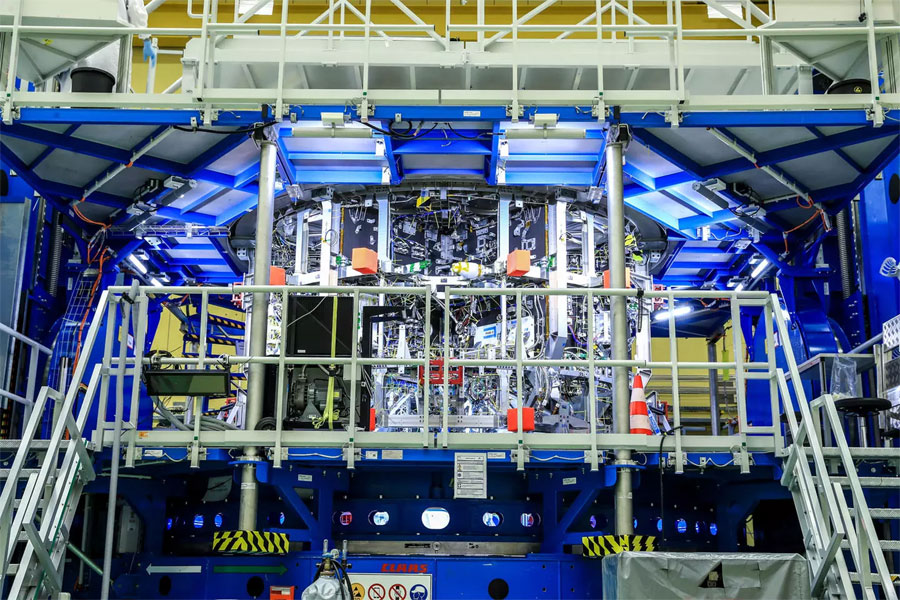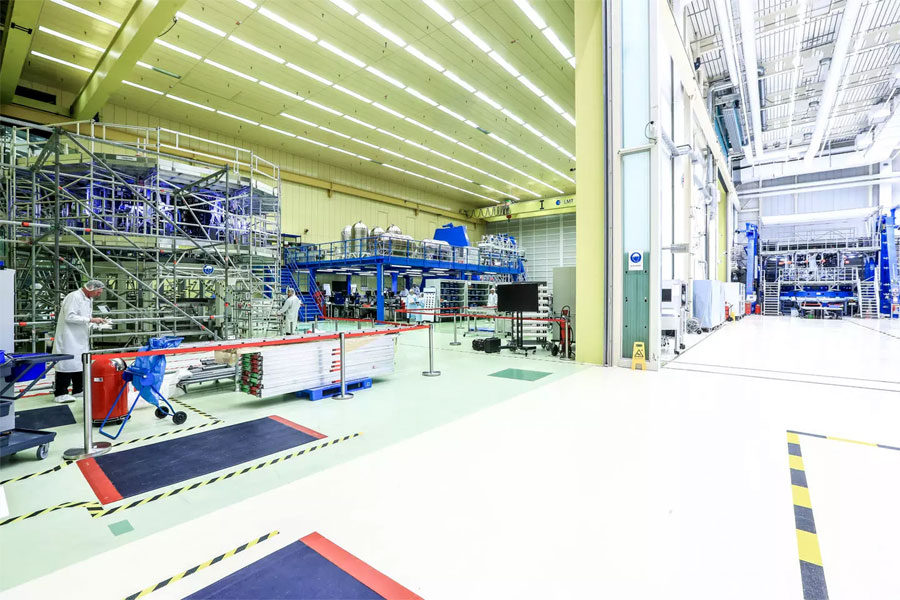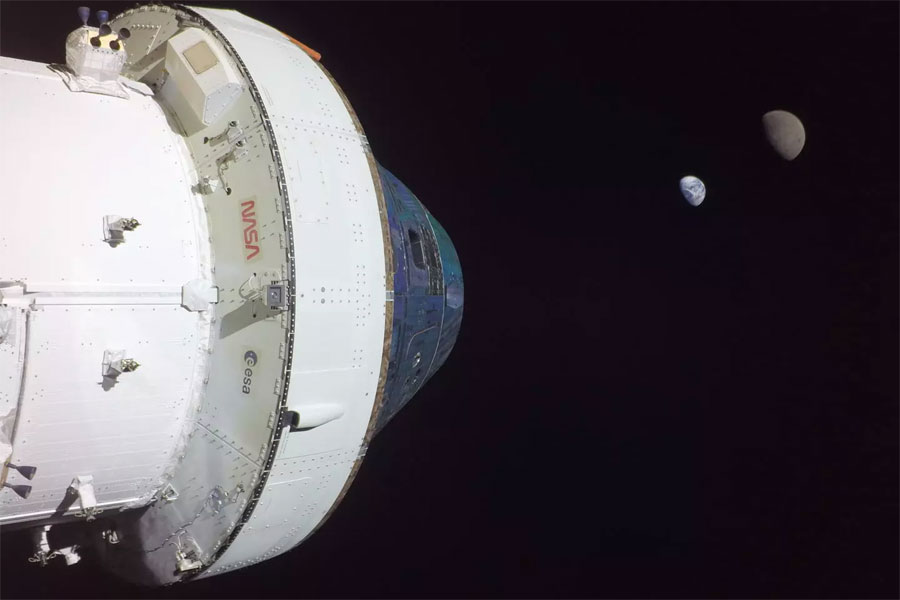Three European Service Modules (ESM-3, ESM-4 and ESM-5) are being integrated in parallel in Airbus’ Bremen cleanrooms.
~
Press Release, Bremen, 9 February 2023: Three European Service Modules (ESMs) are being integrated in parallel in Airbus’ Bremen cleanrooms. Integration of ESM-3 is almost complete and ESM-4 is well under way, and the newly arrived ESM-5 structure is now the focus of initial integration steps.
Each ESM requires the integration of more than 22,000 elements. This is the first time ever that NASA has entrusted a non-US prime, Airbus through ESA, to build a mission-critical element for an American human spaceflight mission.
“Together with the European Space Agency, Airbus is providing half the spacecraft that will return humans to the Moon – taking them further than ever before into space and of course returning them safely to Earth,” said Marc Steckling, Head of Space Exploration at Airbus. “We have already delivered the first two ESMs, with ESM-2 currently being integrated in Orion at Kennedy Space Center. With the arrival of the ESM-4 structure last summer and that of ESM-5 just before Christmas, we have now started the serial production phase. Our cleanroom facilities have been optimised to accommodate three ESMs at the same time, and we are on track to meet NASA’s requirement to deliver one ESM per year going forward.”
The ESM is a critical element of NASA’s crewed Orion spaceship as it provides the spacecraft’s main propulsion system while also enabling orbital manoeuvring and positioning control. Electrical power generation and distribution are also provided by the ESM along with supplying the crew with the central elements of life support such as water and oxygen. The ESM also regulates thermal control while it is connected to the crew module. In addition, the unpressurised service module can be used to carry additional payloads. ESA has invested about €2 billion in the Orion programme and contracted Airbus to lead the European consortium and build six ESMs to date.
2022 saw the first Artemis mission with the first Orion spacecraft powered by the ESM-1. The spacecraft travelled more than 2 million kilometres, was exposed to a temperature range wider than 200°C and flew at a maximum speed of 40,000 km/h (or 11 km/s). All systems were tested and performed well and reliable, some even better than expected.
- ESM-2 was delivered to Florida in October 2021. It is now being tested and integrated at the Kennedy Space Center. It will be part of the crewed Artemis II Mission, which will fly the first astronauts around the Moon and back to Earth since 1972. The Artemis II launch is currently planned for 2024.
- ESM-3, undergoing final integration, will power the Artemis III Mission, set to see the first woman and first person of colour setting foot on the Moon. The delivery of ESM-3 is planned for the second half of 2023. This mission is envisaged for no earlier than 2025.
- The ESM-4 structure arrived at Airbus’ Bremen cleanroom in June 2022 and is currently being integrated. The recently arrived ESM-5 structure is already being worked on.
ESMs 4, 5 and 6 will be used for the Artemis IV to VI missions, the first two of which are part of the European contribution to the international Gateway, a space station planned to be assembled in lunar orbit. ESA and NASA are aiming to establish a Moon ecosystem (Gateway, Argonaut) to better understand and explore all the Moon has to offer and in the longer-term to prepare for crewed missions to Mars. Further ESMs 7, 8 and 9 were authorised at the ESA ministerial council in November 2022, and Airbus is currently finalising its offer to provide them.
The Orion ESM is cylindrical in shape and approximately four metres in diameter and height. At launch, it weighs just over 13 tonnes, making up roughly 60% of the Orion spacecraft’s total mass. Its 8.6 tonnes of fuel power the main engine, eight auxiliary thrusters and 24 smaller thrusters used for attitude control. The European Service Module is installed underneath the crew module at Kennedy Space Center in the USA. Together, they form the Orion spacecraft.
Airbus engineers produce the ESMs together with ESA and industry partners, including suppliers from 10 countries. ESM manufacturing builds on Airbus’ experience gained on the Automated Transfer Vehicle (ATV), which flew five times to the ISS between 2008 and 2015.
Artemis I complete success: Artemis I was the first in a series of increasingly complex missions to provide a foundation for human exploration in deep space and a major step toward returning astronauts to the Moon with Europe as a leading player in humankind’s greatest space adventure to date.
This first flight was a huge source of information and all mission objectives linked to the ESM were fully achieved. Initial evaluation of the test data has confirmed that the Orion spacecraft consumed much less propellant and electrical power, while producing much more power than calculated. The propulsion subsystem performed as expected delivering the thrust for precise orbital manoeuvres and vehicle attitude control. The good performance of the propulsion system allowed the execution of additional flight test objectives to better characterise the vehicle. The ESM main engine was fired multiple times with an accumulated total burn duration of 10 minutes, as planned. NASA has confirmed that the overall mission performance achieved was above expectations with almost 2 tonnes of propellant remaining at the end of mission. This will allow future missions of longer duration or higher mass (e.g. Gateway modules being transported by ESM). Most impressively, the solar arrays generated 15% more electrical power than specified. At the same time, the spacecraft consumed less electricity due to smaller fluctuations in temperature than expected.
~
Editor’s Footnote: The JOINT-FORCES team was invited to Bremen for the ESM ‘Three In A Row’ media facility but regrettably neither Bob nor Carl could attend due to prior commitments
<>






















